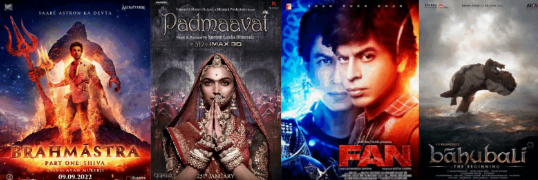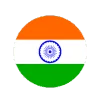Let us take a walk down memory lane! Remember that feeling of popcorn in your hands and a captivating colorful animated film playing in the dark halls of the theatre? The cars that could speak and race against each other? The squirrel running after a nut amidst the snowy mountains? The toys that could come to life? Or maybe, the house that could fly with the help of balloons? I am sure I don’t even have to name these movies. The titles are already imprinted in your mind. However, what is it that made these movies stand out? The storyline? Yes. High-quality 3D animation? DEFINITELY YES!
THE ORIGIN OF INDIAN ANIMATION STUDIOS

When you think of the Indian film business, the animation is hardly the first thing that springs to mind. In fact, until quite recently, animated films were not even considered in the Indian context. Indeed, for most millennials, animated films were “imports” more than anything else when they were growing up. The origins of animation in India can be traced back to the early 20th century. Shadow puppets and slide shows were the forefathers of what later became the animation industry. Clair Weeks’ visit to the Film Divisions of India turned the tide for animation in India. A Disney animator who had worked on successful projects like Snow White & the Seven Dwarfs, as well as Bambi, Weeks, helped to establish the first animation studio in India. The trained animators hired by this studio went on to make “The Banyan Deer” (1957), which became India’s first coloured animated movie. Withal, the Indian animation industry became a stalemate in the 80s as no more initiatives were taken to develop this sector. Some attempts were made, but they coil; they don’t touch the very peaks of success. Take Roadside Romeo, for example, India’s first 3D animated film made as a collaboration between Yash Raj Films and the Indian division of Walt Disney. Cut forward to 2022, technology has advanced, and animation has taken on a new meaning. Indian animators have started to let animation and VFX take a bigger section of their budget for movies. However, they’ve started producing more animated movies for OTT platforms. For example, a major Indian animated series that caught everyone’s eye was “The Legend of Hanuman”, which was released on Disney Hotstar.
THE EVOLUTION OF ANIMATED MOVIE MAKING IN INDIA
The state of 3D animation and filmmaking in India is continuously improving. More artists are getting adept at their craft, and the animation business is growing in popularity. There are several prospects for advancement in the profession and a competitive pay scale, and it is an exciting moment to be involved in Indian 3D Animation and filmmaking. The future of 3D animation and filmmaking in India is bright, and we are confident that it will continue to grow significantly. Computer-generated 3D animation has already had a huge influence on Indian filmmaking, and it will only grow more common in the coming years.
TRADITIONAL ANIMATION

Traditional animation, popularly known as 2D animation, formed the backbone of the animation we see today. Animation studios used this technique to produce various movies like
- Hanuman
- Return of Hanuman
- The Legend of Buddha
- Banda Singh Bahadur
Indian animation studios were and are big in the 2D animation sector. This is because producing 2D projects is less time-consuming and is open for more experimentation. 2D animation is the process of generating two-dimensional cartoons while giving them life, movement, and personality. The sketches generated by hand serve as the foundation for this animation style. As a result, having strong expertise as a cartoonist is one of the primary requirements for learning this approach. Indian animation studios have expert cartoonists and animators who help achieve this goal with perfection.
3D ANIMATION

Many Indian animation studios have brought some 2D characters to life using 3D modelling and animation, and their names are now household names. Characters from Mahabharat, Ramayana, and Bal Ganesh may be included. In reality, Indian animators have collaborated on multiple animated films with Pacific Rim countries such as Japan, China, and Korea, including Ramayana, The Swan Princess, and The Hero of Colour City. With the growing popularity of animated films, we may expect to see some remarkable things done in the Indian animation industry in the future. Computer graphics and animation have already influenced Indian filmmaking, and we can only anticipate what incredible things may be made in the future with them.
VFX INDUSTRY

India has become a hub for avant-garde VFX studios. The industry has taken a huge leap from being a minor part of movies and their title sequences to creating world records for the most number of VFX shots in one movie. In his recent blockbuster, Namit Malhotra’s prime focus was the VFX of his movie. Bhramastra broke records by encompassing 4500 VFX shots, the most for any international film ever made. Sanjay Leela Bhansali, too, used the benefits of VFX in his controversial movie- Padmavat. In response to the Rajput Karni Sena’s insistence that Rani Padmini dance and show her midriff, director Sanjay Leela Bhansali devised a plot. Instead of reshooting the song, the film went through one last cut with a sanskari midriff in place. In several places, Deepika’s bare waist has been covered with a saffron scarf; however, this is a VFX effect. The VFX division of Shah Rukh’s own production house Red Chillies was behind the animation and visual effects generated to make Fan. Watch this video to learn how they reduced SRK’s body, nose, and height to make him leaner and younger. In India, Baahubali has become a household name regarding VFX. The full post-production process required approximately 3000 pictures and five months. The actors dedicated themselves to this franchise and did not take on any other projects during this period. The audience was enthralled by Baahubali’s ability to make historical drama appear true and otherworldly. People couldn’t stop wanting more.
ADVERTISING WITH THE HELP OF ANIMATION STUDIOS
In the world of infinite creativity, animated commercials carry the ability to kindle curiosity in the minds of the target audience innovatively. It has been said that your imagination is the limit, and with the swift rise in technology, it truly is the only limit. A commercial advertisement aims to grab attention and generate curiosity about a product, service or brand. These videos can potentially influence a wide range of audiences via targeted campaigns. In short, animated ads are short commercial cartoon videos that promote a company’s products/ services. Indian brands have always selected the best 3D /2D animations for their commercial advertisements. Some of the most famous examples of animated advertisements are created in India-based animation studios.
VODAFONE ZOOZOOS ADVERTISEMENTS
Launched in 2009 by Vodafone, the ZooZoos ad campaign was one of the most successful commercial endeavours. In contrast to popular beliefs, ZooZoos were not animated characters. They were humans wearing costumes. So, where did the animation studio come into play? Character modelling, lighting, rendering and sound effects were added in the post-production phase with the excellent use of VFX. All of this was made possible by the top-notch animation studios in India. The finalised product made it seem as if the entire advertisement was animated.
MTS BABY ADVERTISEMENT
This stunning advertisement depicts a baby’s relationship with technology from the minute it is born. The infant may be seen cutting its umbilical cord and snapping a picture with the nurse. This is live-streamed from the smartphone camera, along with a safe path home, thanks to the seamless GPS experience. Naturally, the infant and its associated actions were made utilising animation and VFX. The ad’s aim that the internet is for everyone was properly served, and they are one of the quickest suppliers of the service. The animation makes the commercial appear amusing while providing information about the brand’s offerings.
KITKAT ADVERTISEMENT
The Kit Kat commercial had babies in a hospital ward playing with their toys and dancing to the doctor when they saw Kit Kat chocolate. The brand conveyed the concept that chocolate is both refreshing and pleasant. It also emphasised the significance of taking a break. The babies in the commercial were all genuine, but the dancing and giggling were all computer-created. Every aspect was considered, and the commercial was hugely successful due to its adorable element.
OUTSOURCING HUB

A VARIETY OF SERVICES

Services provided by Indian animation studios are not just limited to VFX or adverts. They include an array of provisions like explanation videos, blockchain games, game development, VR AR, XR, MR METAVERSE, and drawings with background music, voiceovers, or subtitles. Services such as animation studios not only help to develop the company itself but also advertises several other small and large businesses by creating technological art for them. They provide jobs to countless youths across the country, helping them explore their talents and learn more about their passions.
CHALLENGES FACED BY THE ANIMATION INDUSTRY IN INDIA

SCARCE HUMAN RESOURCES
Today, one of the most pressing issues confronting India’s 3D animation and filmmaking industries is the scarcity of experienced artists. While the country has many outstanding artists, there are not enough to match the demand. As a result of a shortage of human resources, many projects are delayed or terminated.INADEQUATE FUNDING
A shortage of finance is another issue confronting the animation business. While some government programmes offer financial aid to filmmakers, they are frequently insufficient. This might make it difficult for great filmmakers to complete their movies because the animation and visual effects need a significant budget.INSUFFICIENT AWARENESS
Finally, another issue confronting the sector is a lack of awareness. Many people in India are still ignorant of animation and filmmaking’s possibilities. As a result, more education and outreach are required to show people what this medium is capable of.UNORIGINAL CHARACTERS
The majority of Indian animated films are inspired by Indian mythology. As a result, the personalities created may not have universal appeal and may be regarded as repetitious.LOGGING OUT
With multiple animation studios around the country, 3D animation and filmmaking are gaining popularity in India. Filmmakers may use 3D Animation to create realistic and lifelike characters, environments, and objects, creating a degree of immersion that traditional 2D Animation cannot equal. As a result, 3D Animation is increasingly being employed in Indian films and television shows. The future of 3D animation in India is bright as more filmmakers and television show creators continue to explore the potential of this new medium. This is expected to have a significant impact on the future of Indian filmmaking and potentially transform the industry.









 (03KEUPK4394K1ZN)
(03KEUPK4394K1ZN)